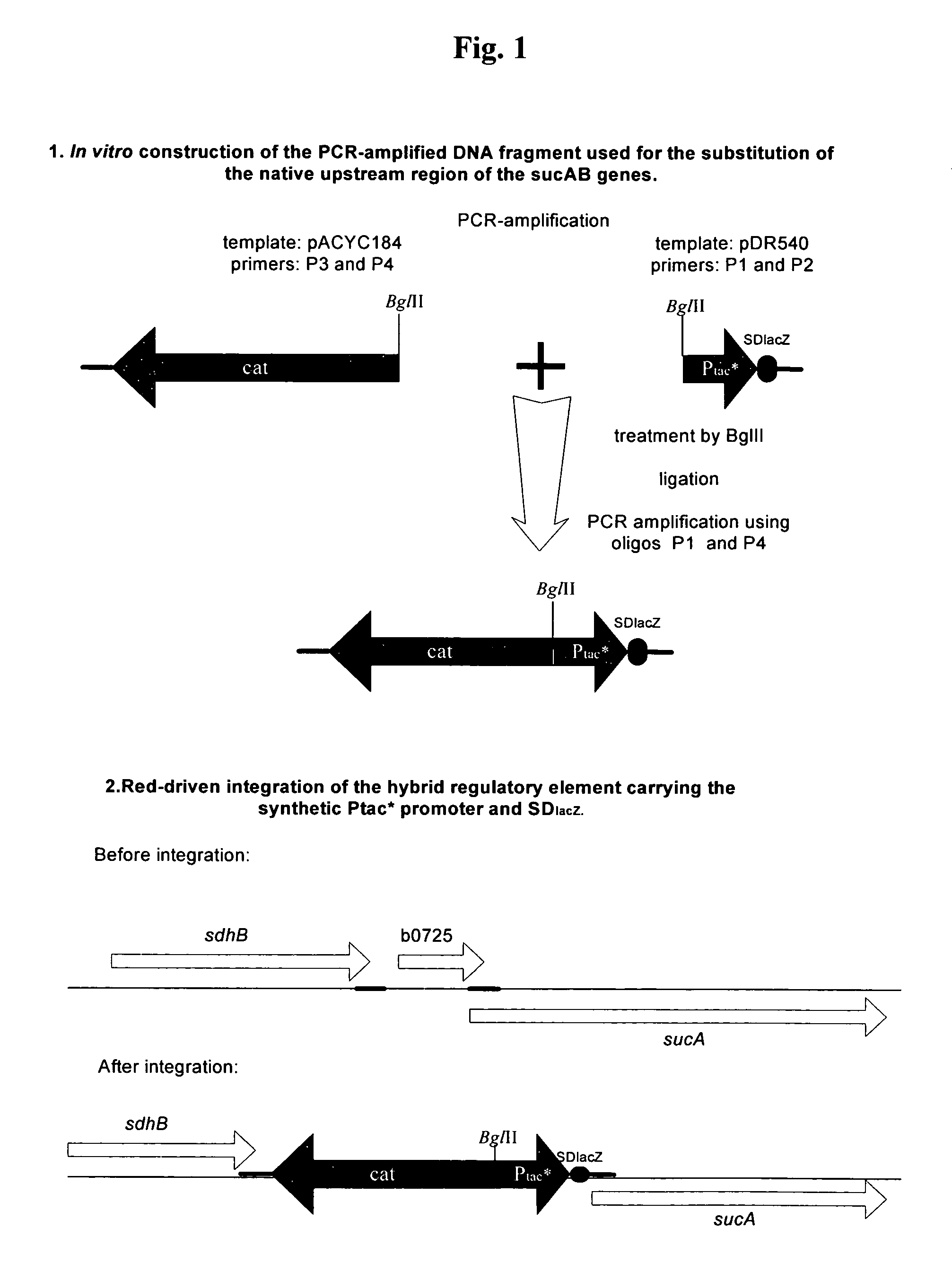Method for producing an L-amino acid using a bacterium with an optimized level of gene expression
a technology of gene expression and bacterium, which is applied in the field of producing l-amino acids using bacterium with an optimized level of gene expression, can solve the problems of reducing the ability of the bacterium to produce the target compound, and affecting the production efficiency of the target compound
- Summary
- Abstract
- Description
- Claims
- Application Information
AI Technical Summary
Benefits of technology
Problems solved by technology
Method used
Image
Examples
example 1
Substitution of the Native Upstream Region of sucAB-genes on the E. coli Chromosome with a Hybrid Regulatory Element having the Synthetic Ptac*-promoter and SDlacZ
[0045]A modified Ptac*-promoter linked to the Shine-Dalgarno sequence (SD sequence) from the lacZ gene derived from E. coli was integrated upstream of the sucAB coding region into the chromosome of the E. coli strain 702ilvA[pAYCTER1-cpg] in place of the native region by the method described by Datsenko, K. A. and Wanner, B. L. (Proc. Natl. Acad. Sci. USA, 97, 6640-6645, 2000) also called a “Red-mediated recombination” or “Red-driven integration.” The modified Ptac*-promoter contained only the first 11 bp of the 21 bp lactose operator (Olac), resulting in an inability to interact with the lactose repressor because of the absence of the nucleotides essential for the specific DNA-protein interactions. In addition, the artificial DNA fragment which contains the chloramphenicol resistance gene (CmR, or cat) is linked to the 5...
example 2
Influence of the Ptac* Promoter on the Activity of α-ketoglutarate Dehydrogenase and Production of L-glutamic Acid and L-proline
[0053]A full loop of each strain 702ilvA [pAYCTER1-cpg] and 702ilvA tac* [pAYCTER1-cpg] from the L-agar plate was inoculated into Erlenmeyer flasks containing 75 ml of medium having 10 g / l Tryptone, 5 g / l Yeast extract, 4 g / l NaCl, and 25 μg / ml streptomycin for stabilization of the recombinant plasmid pAYCTER1-cpg, and incubated for 6 h at 37° C. with agitation (rotation speed: 140 rpm). Then, 50 ml of the resulting culture was inoculated into a Jar-fermentor (“Marubishi”, Japan). The medium for Jar-fermentation (total volume 500 ml) consists of: 100 g / l glucose, 2 g / l (NH4)2SO4, 1 g / l KH2PO4, 0.4 g / l MgSO4.7H2O, 0.01 g / l FeSO4.7H2O, 0.01 g / l MnSO4.5H2O, 0.2 g / l L-isoleucine, Soybean hydrolysate (0.2 g / l of Total Nitrogen), 0.0004 g / l thiamine.HCl, pH 6.7. The fermentation step is aerated by agitation at 900 rpm at 35° C., and the pH is maintained by the ad...
example 3
Preparation of Artificial Regulatory Element Containing a Randomized Region, and Substitution of the Native Upstream Region of the sucAB-Genes with the Artificial Element in E. coli Chromosome
[0061]A set of artificial regulatory elements containing a randomized “−35” region was obtained by PCR using synthesized primers P1 (SEQ ID NO: 2) and PS (SEQ ID NO: 10) and template plasmid pDR540. Primer PS (SEQ ID NO: 10) has 51 nucleotides and has a region with 4 random nucleotides, depicted in SEQ ID NO: 10 by the letter “n”. The resulting artificial DNA fragments contained the hybrid regulatory element with the randomized region and the chloramphenicol resistance gene (CmR). Integration of this fragment into the chromosome was conducted as described in Example 1.
[0062]Colonies of the resulting integrants grown on the L-agar had a different size and growth rate. Selection was based on L-glutamic acid production. The two best clones, No. 2 and No. 21, were selected since they each had the h...
PUM
| Property | Measurement | Unit |
|---|---|---|
| temperature | aaaaa | aaaaa |
| temperature | aaaaa | aaaaa |
| volume | aaaaa | aaaaa |
Abstract
Description
Claims
Application Information
 Login to View More
Login to View More - R&D
- Intellectual Property
- Life Sciences
- Materials
- Tech Scout
- Unparalleled Data Quality
- Higher Quality Content
- 60% Fewer Hallucinations
Browse by: Latest US Patents, China's latest patents, Technical Efficacy Thesaurus, Application Domain, Technology Topic, Popular Technical Reports.
© 2025 PatSnap. All rights reserved.Legal|Privacy policy|Modern Slavery Act Transparency Statement|Sitemap|About US| Contact US: help@patsnap.com

